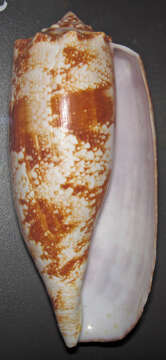Conus geographus (geography cone snail) 2 (24422156255)

Description :
Description: Conus geographus Linnaeus, 1758 - geography cone snail shell (apertural view), modern (latest Holocene). (public display, Bailey-Matthews Shell Museum, Sanibel Island, Florida, USA) The gastropods (snails & slugs) are a group of molluscs that occupy marine, freshwater, and terrestrial environments. Most gastropods have a calcareous external shell (the snails). Some lack a shell completely, or have reduced internal shells (the slugs & sea slugs & pteropods). Most members of the Gastropoda are marine. Most marine snails are herbivores (algae grazers) or predators/carnivores. The conid gastropods (cone shells) are fascinating marine snails for a couple reasons - they have attractively-shaped, colorful shells and they are killers. The conids are predatory, as are many other marine snails, but they take down their prey in an unusual fashion. The radula of most snails is a mineralized or heavily sclerotized mass of small teeth that scrapes across a substrate during feeding. Conid snails have a toxoglossate radula - one that has been evolutionarily modified into tiny, unattached, toxin-bearing, harpoon-like darts (see photo - science.naturkundemuseum-bw.de/files/images/niederhofer_2..) that can be fired at prey. Each dart is an individual tooth. The nickname "killer snails" is well deserved (even people have been killed). Some species have incredibly powerful toxins, while in other species the toxin has little effect on humans. Conus geographus, the geography cone snail, is one of the few species that has killed people. This species occurs in the southwestern Pacific Basin and has been reported to have killed shell collectors. Death occurs by respiratory failure. Classification: Animalia, Mollusca, Gastropoda, Neogastropoda, Conoidea, Conidae More info. at: en.wikipedia.org/wiki/Conus and en.wikipedia.org/wiki/Conus_geographus. Date: 5 January 2016, 12:54. Source: Conus geographus (geography cone snail) 2. Author: James St. John.
Inclus dans les pages suivantes :
- Life
- Cellular (Organismes cellulaires)
- Eukaryota (eucaryotes)
- Opisthokonta
- Metazoa (animaux)
- Bilateria
- Protostomia
- Spiralia
- Mollusca (mollusques)
- Gastropoda
- Caenogastropoda
- Neogastropoda
- Conoidea
- Conidae
- Conus
- Conus geographus
Cette image ne figure dans aucune collection.
Informations sur la provenance
- licence
- cc-by-3.0
- droit d’auteur
- James St. John
- créateur
- James St. John
- source
- Flickr user ID jsjgeology
- original
- fichier de média d’origine
- visiter la source
- site partenaire
- Wikimedia Commons
- ID


